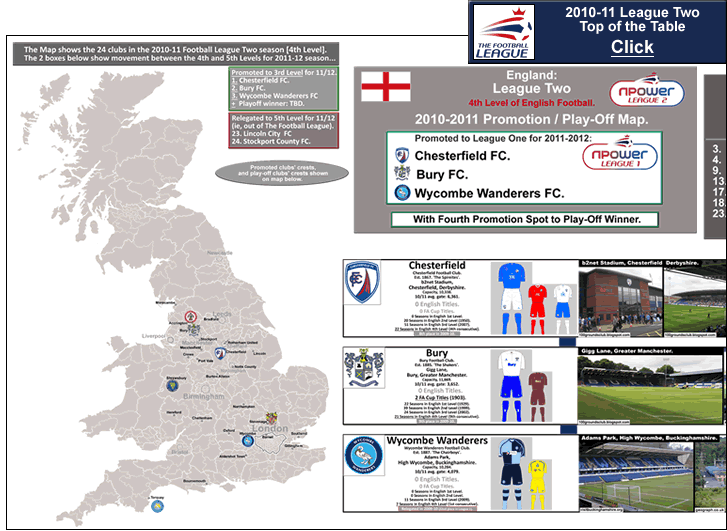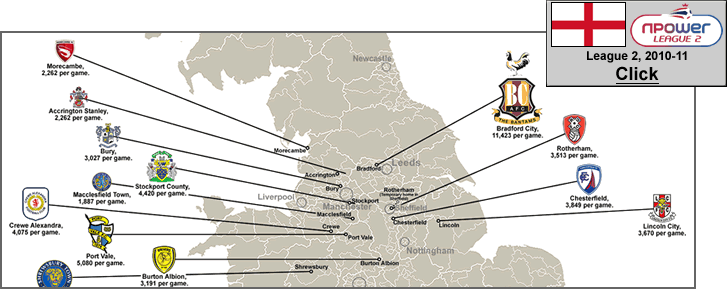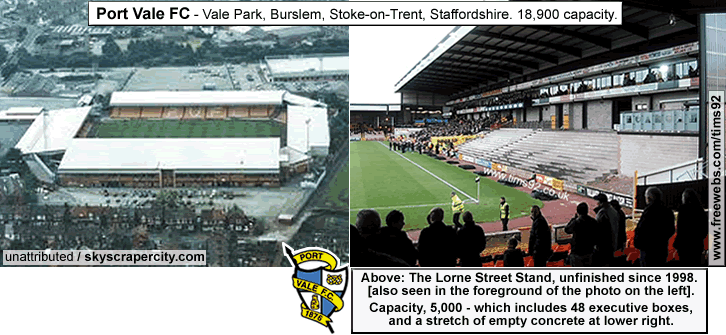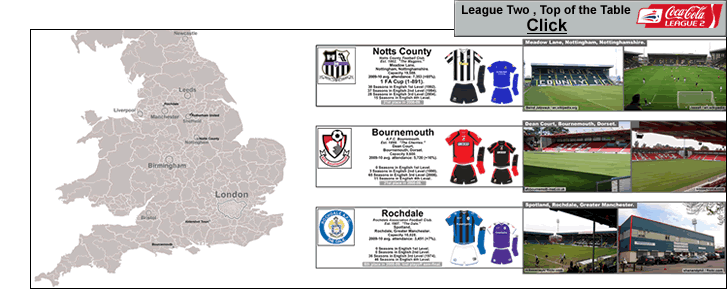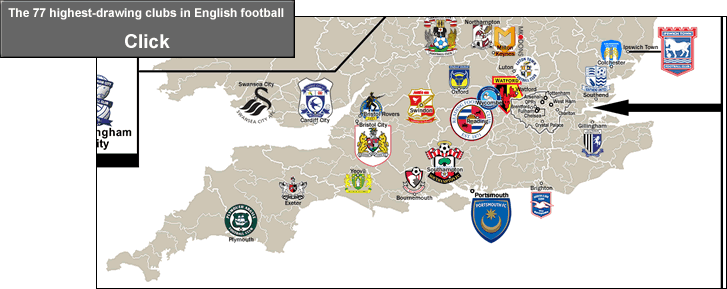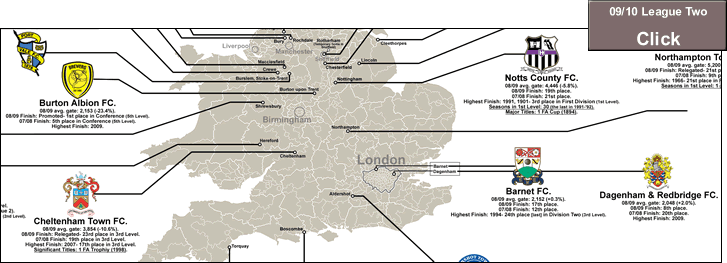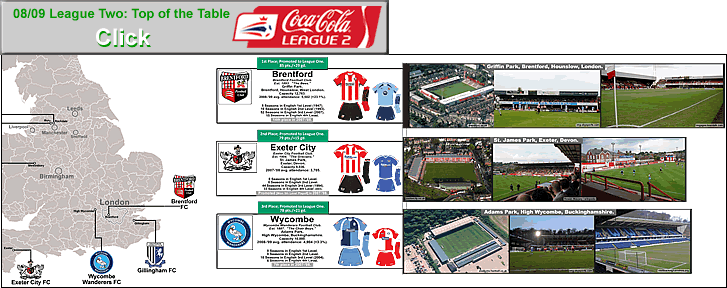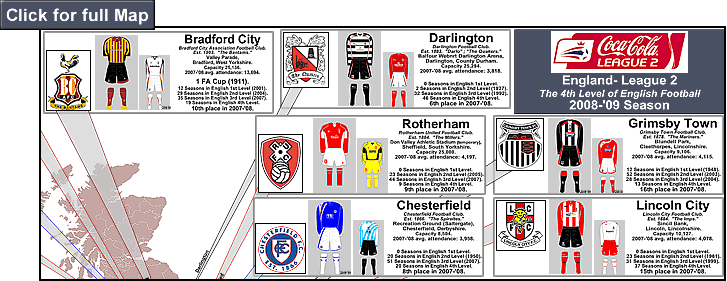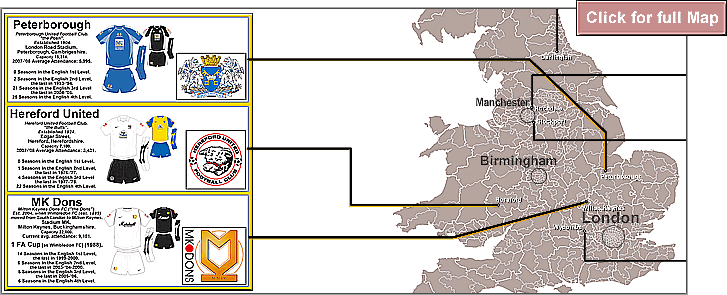
2011-12 League Two Stadia map
…
…
Note: to see my most recent post on the English 4th division, click on the following: category: Eng-4th Level/League 2.
…
On Boxing Day, 2011, League Two is led by Crawley Town. The Red Devils of West Sussex were pretty much expected to be at or near the top of the table this season in the fourth division, because their transfer and wage bill (abetted by anonymous Far East investors) far exceeds other clubs in League Two. A 15-game unbeaten run was ended by Gillingham today, though, but it still looks like Crawley are in prime position to gain their second consecutive promotion under the mercurial Scot, manager Steve Evans. Crawley lead 2nd place Cheltenham Town by 3 points. Cheltenham Town in second place is a shock, seeing as most media outlets and bloggers pegged them for a relegation battle, not a promotion campaign this season. Ex-Robins MF and captain Mark Yates has been managing Cheltenham Town for 2 years now, and his squad plays some nice passing football, and only Swindon Town have less goals conceded (18) than Cheltenham (at 20, tied with Shrewsbury Town). Cheltenham have a stellar away record, boasting 8 wins, then a draw (to Barnet), in their last 9 matches away from Gloucestershire. Cheltehham Town have had two spells in the third tier (for a total of 4 seasons, last in 2008-09), and it’s starting to look like they could be returning to the third division. Perhaps the biggest impediment to their success could be the eventually-chewed-up-turf at Whaddon Road, the result of their groundshare with Gloucester City AFC (of the Conference North). Last year [2010-11], the poor pitch conditions played a part in Cheltenham’s struggles in the second half of the season, but maybe the mild winter, so far, will aid the Robins this season.
In 3rd place (which is an automatic-promotion-place in League Two) are Southend United. The Essex side, under much-travelled Scottish manager Paul Sturrock, shot out of the gate, but now seem to have flagged a little bit, with 4 straight defeats (two league and two cup losses). In 4th place are a club that was expected by most to be in (another) promotion campaign – Shrewsbury Town. The Shropshire-based club are run by longtime Hereford United manager Graham Turner, who returned in July 2010 to the place where he finshed his playing career and began coaching. In 5th place are the Staffordshire-based Burton Albion, who are managed by Canadian international Paul Peschisolido. In 6th place are the Kent/Thames Estuary side Gillingham, who are managed by Dartford, Kent-born Andy Hessenthaler. In 7th and in the final play-off spot are Wiltshire’s Swindon Town, who are managed by Rome, Italy-born West Ham legend Paolo Di Canio.
From Guardian.co.uk/Football League Blog, ‘League Two 2011-12: the bloggers’ half-term report
The people who really know their clubs give us the lowdown on the League Two season so far‘.
…
On the map page, which you can see by clicking on the segment at the top of this post, you can see stadium photos of all 24 clubs in the 2011-12 season of the English Football League Two. Alongside each stadium image, club info is provided – club crest, year of formation, location, stadium capacity, 2010-11 average gate, list of the seasons spent by the club in each of the top 5 Levels of English football, and 2011-12 kits. At the far right on the map page is a location-map of the 2011-12 League Two. At the lower right of the map page are 2010-11 and 2009-10 average attendance figures (from home league matches), as well as league movement (if any) these last 2 seasons.
…
Below are photos of the grounds of the top four clubs in the League Two table as of 26 December, 2011 – 1st place, Crawley Town (Broadfield Stadium). 2nd place, Cheltenham Town (Whaddon Road). 3rd place, Southend United (Roots Hall). 4th place, Shrewsbury Town (Greenhous Meadow). Also included are photos of standout players on the squads (including team goals and assists leaders), as well as photos of the managers.
Crawley Town. Est. 1896. The Red Devils. Broadfield Stadium, cap. 4,996. Crawley, West Sussex.
First season in the Conference [5th Level], 2004-05. First season in the Football League: 2011-12.
2010-11 avg. gate (home league matches), 2,535 per game (up +152.8%).
Current {26 Dec., 2011} avg. gate, 3,198 per game (up +26.0%).

Crawley Town Image and Photo credits – Aerial view of Broadfield Stadium from bing.com/maps/. Entrance photo by Shaun at 100groundsclub.blogspot.com Photo of West Stand [at center] by Peer Pawelczyk via soccerway.com. Photo of terrace [at lower center] by Smidrophenia at flickr.com. Photo of Broadfield Stadium [at far left] from worldgroundhop.blogspot.com. Photo of West Sussex countryside by PhillipC at tripwolf.com. Matt Tubbs photo from skysports.com. Tyrone Barnett action photo by Frances Leader/Action Images via guardian.co.uk/football/football-league-blog; Tyrone Barnett photo in white kit from football365.com. Action photo including Kyle McFadzean from crawleytownfc.com/gallery. Andy Drury photo from thisissussex.co.uk. Steve Evans photo by Michael Steele/Getty Images Europe via zimbio.com.
…
Cheltenham Town. Est. 1887. The Robins. Whaddon Road, cap. 7,066. Cheltenham, Gloucestershire.
First season in the Conference [5th Level], 1988-89. First season in the Football League: 1999-2000.
2010-11 avg. gate (home league matches), 2,980 per game (down -8.1%).
Current {26 Dec., 2011} avg. gate, 3,339 per game (up +20.%).

Cheltenham Town Image and Photo credits – Aerial view of Whaddon Road from bing.com/maps. Small photo at upper right from wolves-stats.co.uk/Cheltenham_Town. Large photo of Cheltenham from the adjacent hillside by Adrian Pingstone at en.wikipedia.org/Cheltenham. Small photo of the three stands [at the center] by footix at Panoramio.com. Exterior photo [at lower left] from thisisgloucestershire.co.uk/. Photo from inside the stands [at lower left] from http://www.courtoffside.com/forum/album.php?albumid=15. Large photo of Main Stand by Shaun at 100groundsclub.blogspot.com.
Jimmy Spencer, Darryl Duffy, and Kaid Mohammed action photos from CTFC.com/galleries. Marlon Pack action photo from features.rr.com; Marlon Pack photo from teamtalk.com/cheltenham-town. Mohammed/Jombati/Smikle celebrating photo from ctfc.com/Gallerycirencesterpeople.co.uk. Photo of Mark Yates from http://www.thisisgloucestershire.co.uk/football.
…
Southend United. Est. 1906. The Shrimpers. Roots Hall, cap. 12,392. Southend-on-Sea, Essex.
First season in the Football League: 1920-21, charter member of the Third Division.
2010-11 avg. gate (home league matches), 5,274 per game (down -31.6%).
Current {26 Dec., 2011} avg. gate, 5,801 per game (up +9.9%).

Southend United Image and Photo credits – Aerial view of Roots Hall, bing.com/maps. South Stand photo [at top, center] from footballstadiumguide.co.uk/southend-united. Roots Hall main entrance and camera gantry photos from portmanroadtothesansiro.blogspot.com. Fans in South Stand with flags from footybunker.com. Roots Hall photo at far left by Shaun at 100groundsclub.blogspot.com. Aerial photo of Southend-on-Sea by terryjoice at en.wikipedia.org/Southend-on-Sea. Liam Dickinson photos from southendunited.co.uk. Kane Ferdinanand photo from flblog.dailymail.co.uk, ‘Talent scout: Southend United’s Kane Ferdinand‘, by Joe Ridge. Ryan Hall photo from southendunited.co.uk/page/Gallery. Photo of Paul Sturrock with squad at Roots Hall from echo-news.co.uk/sport; Paul Sturrock photo from football.co.uk/southend_united.
Images of old Southend United kit badges are from Historical Football Kits site at http://www.historicalkits.co.uk/Southend_United/Southend_United.htm.
…
Shrewsbury Town. Est. 1885. The Shrews. Greenhous Meadow, cap. 9,875. Shrewsbury, Shropshire.
First season in the Football League: 1950-51
(Shrewsbury Town were elected to the Football League, Division Three North in 1950, after being Midland League champions in 1949-50).
2010-11 avg. gate (home league matches), 5,876 per game (down -7.5%).
Current {26 Dec., 2011} avg. gate, 5,436 per game (up +6.4%).

Shrewsbury Town Image and Photo credits – Aerial photo of New Meadow (aka Greenhous Meadow) from forums.electronicarts.co.uk. Main entrance photo from thegroundhog.wordpress.com. Pre-match photo of New Meadow by ynysforgan_jack at Flickr.com. The Old Market Hall in Shrewsbury photo by Asdfasdf1231234 at en.wikipedia.org/Shrewsbury. River Severn at Shropshire photo from sirpetespics.blogspot.com. Old kit badges of Shrewsbury Town from historicalkits.co.uk/Shrewsbury_Town. South Stand photo from the-prostar-stadium.blogspot.com. Mark Wright photo from shrewsburytown.com/Gallery. Lionel Ainsworth photo from AMA Sports photo agency via shropshirestar.com. James Collins photo by Julian Finney/Getty Images Europe via zimbio.com. Graham Turner photo from shrewsburytown.com.
…
After 22 matches played by most clubs in the 2011-12 League Two season, here are the 3 top scoring leaders and the top player in assists…
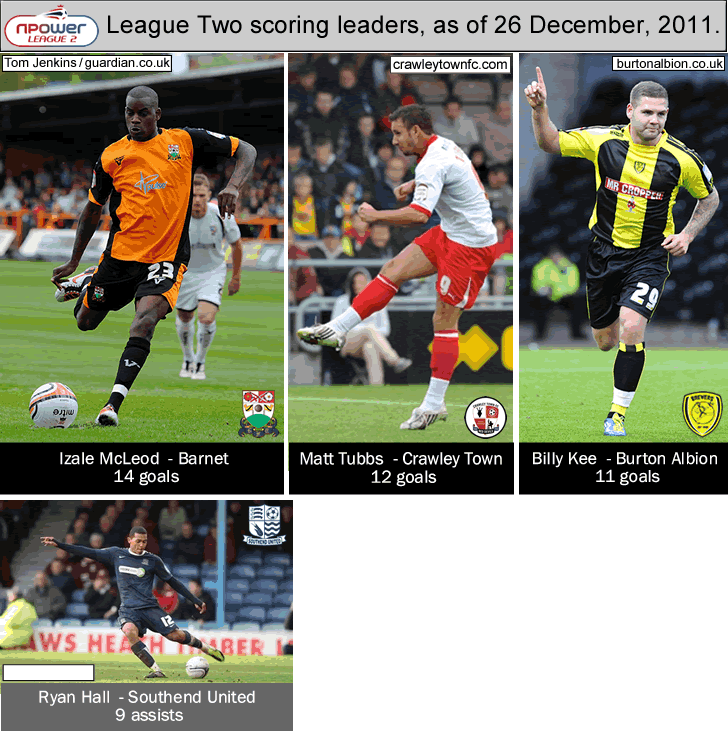
Photo credits above – Izale McLeod photo by Tom Jenkins at Guardian.co.uk. Billy Kee photo from burtonalbionfc.co.uk/gallery. Matt Tubbs photo from crawleytownfc.com/gallery. Ryan Hall photo from indiatimes.com.
…
Last season [2010-11], League Two as a whole averaged 4,175 per game, which was an 8.3% increase over 2009-10. Currently [26 Dec., 2011] League Two’s average attendance is 4,252 per game, which is a 1.8 percent increase from last season. [Current League Two attendance, including unofficial league average (ESPN Soccernet).
At the end of each League Two season, 4 clubs gain promotion to League One [which is the 3rd Level of English football]. First, second, and third place finishers get promoted automatically to League One each May, while the 4th through 7th place finishers compete in a play-off to determine the fourth promoted club. On the other hand, at the end of each League Two season, only 2 clubs are relegated to the Conference National [which is the 5th Level of English fooball, and the highest level in Non-League football]. League Two is the only level in the Fooball League that has a disparate number of promoted teams versus relegated teams [the other levels, the Football League Championship (the 2nd Level) and the Football League One (the 3rd Level), have 3 go up and 3 go down each season]. Currently, the clubs in the League Two relegation places are Plymouth Argyle and Northampton Town, with Dagenham & Redbridge, Hereford United, and Barnet within touching distance of the dreaded drop.
_
Photo credits on map page -
Accrington Stanley/Crown Ground, bing.com/maps/Bird’s Eye satellite view.
AFC Wimbledon/Kingsmeadow (aka Cherry Red Records Stadium), bing.com/maps/Bird’s Eye satellite view.
Aldershot Town/The EBB Stadium (Recreation Ground), bing.com/maps/Bird’s Eye satellite view.
Barnet/Underhill Stadium, bing.com/maps/Bird’s Eye satellite view.
Bradford City/Valley Parade, bing.com/maps/Bird’s Eye satellite view.
Bristol Rovers/Memorial Stadium, bing.com/maps/Bird’s eye satellite view.
Burton Albion/Pirelli Stadium, http://mw2.google.com/mw-panoramio/photos/medium/4422509.jpg.
Cheltenham Town/Whaddon Road (aka Abbey Business Stadium), bing.com/maps/Bird’s Eye satellite view.
Crawley Town/Broadfield Stadium, bing.com/maps/Bird’s eye satellite view.
Crewe Alexandra/Alexandra Stadium, shepherd-gilmour.co.uk.
Dagenham & Redbridge/Victoria Road, bing.com/maps/Bird’s Eye satellite view.
Gillingham/Priestfield, bing.com/maps/Bird’s Eye satellite view.
Hereford United/Edgar Street, bing.com/maps/Bird’s Eye satellite view.
Macclesfield Town/Moss Rose, bing.com/maps/Bird’s Eye satellite view.
Morecambe/Globe Arena, sixtamesides.blogspot.com.
Northampton Town/Sixfields Stadium, bing.com/maps/Bird’s Eye satellite view.
Oxford United/Kassam Stadium, footballaway.co.uk.
Port Vale/Vale Park, bing.com/maps/Bird’s Eye satellite view.
Plymouth Argyle/Home Park, bing.com/maps/Bird’s eye satellite view.
Rotherham United/Don Valley Stadium, bing.com/maps/Bird’s Eye satellite view.
Shrewsbury Town/Greenhous Meadow [aka New Meadow], James Humphries (aka Colds7ream) at en.wikipedia.org/wiki/New_Meadow.
Southend United/Roots Hall, bing.com/maps/Bird’s Eye satellite view.
Torquay United/Plainmoor, bing.com/maps/Bird’s eye satellite view.
Thanks to the contributors to the pages at en.wikipedia.org, ‘2011–12 Football League Two‘.
Thanks soccerway.com for current attendance figures.
Thanks to European-football-statistics.co.uk, for attendance data from previous seasons.
Thanks to these two sites…
1). Data for ‘Seasons spent in Levels’ lists, thanks to http://stats.football365.com/hist/tier3/attable.html [data up to 2001-02].
2). For league placement data from 2002-03 and on, plus general data on the clubs’ league placement through the years, thanks to Footy-Mad.co.uk sites of each club, usually [at the top menu bar there] at ‘Club/League History’. Example, Barnet-mad.co.uk.
Thanks to historicalkits.co.uk, for images of old kit badges.
Thanks to crawleytownfc.com.
Thanks to [Cheltenham Town] CTFC.com.
Thanks to southendunited.co.uk.
Thanks to shrewsburytown.com.

